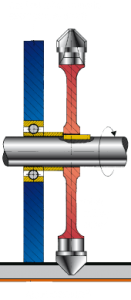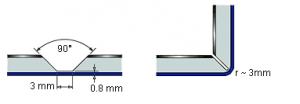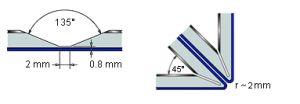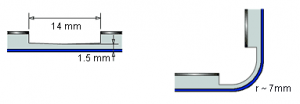ALUCOBOND® PLUS composite panels can be shaped using a very simple
processing method. The technique – called the routing and folding method – enables a fabricator to produce shapes
of various kinds and sizes. A V-shaped or rectangular groove is routed on the reverse side of the ALUCOBOND® PLUS
composite panel using a disk or end milling cutter. A thin layer of the core material should be left at the base
of the groove, i.e. on the inside of the outer cover sheet. The untouched outer cover sheet can now be bent manually,
giving an exact and clean folding line which follows the routed groove.
The outer radius of the folded edge depends on the shape of the groove and its depth. We recommend
that routing should be done using a vertical panel saw equipped with ALUCOBOND® PLUS grooving accessories, a
CNC machining centre, a portable sheet milling machine, or a handheld router. The routing and folding method
can be used for ALUCOBOND® PLUS composite panels with all available standard surface finishes.

important: When folding ALUCOBOND® PLUS with an anodized surface, the folded edges are brighter
Advantages
The convincing advantages of this unique technique are:
- Low investment cost
- Simple fabrication technique
- Folding can be done on site, saving transportation cost
- Low-cost fabrication of shaped components used in fascia and wall cladding, roof edgings, column cladding, flashings, etc.
- Flexibility in creating shapes
- Very economical
- Shapes are not limited by machine capacity
- The fabrication of shaped components using ALUCOBOND®PLUS only requires a minimal investment outlay.
- Hand routers and sheet milling machines are inexpensive and can be used either in the workshop or on site.
- The fabrication of shapes in larger quantities is particularly economical using vertical panel saws equipped with ALUCOBOND®PLUS grooving accessories.


